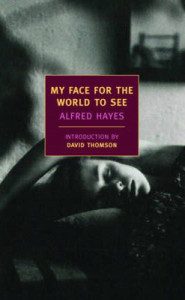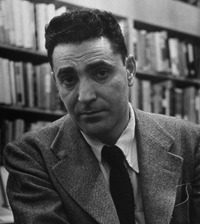
I can still recall the moment I learned what the glasses on the billboard meant in The Great Gatsby. A rush of cognition, and then—nothing. I understood what was to be understood, so I tuned out again, fingering the rough paper of those high school lit classics I’d learned to hate. Gatsby is a darling of the secondary English curriculum; although it shows only a distorted fraction of Fitzgerald’s talent, it has themes, motifs and symbols you can teach as dryly as you would trinomials, and then quiz on.
My Face for the World to See by Alfred Hayes (originally published in 1958, then by NYRB in 2013) is a book that looks like Gatsby—clean, short, sexy, and isn’t love just tragic?—but it serves as a fine foil. The Hayes made me sad, much sadder than any other book I read in the past year—a list that includes Ford’s Independence Day, Gaitskill’s Veronica, and Yates’s Revolutionary Road—and I owe this emotion to the realism that Hayes achieves in his refusal to put meaning behind anything. He continually carves out vessels for metaphor, but never fills them with anything at all.
To discuss metaphor (and Hayes’s neglect of it), let’s go back, back even before high school, to the third grade. Around the time eight- and nine-year-olds learn about Johnny Appleseed and the types of clouds, they’re introduced to one of literature’s most devastating devices. To them, what’s most important is that, unlike simile, metaphor equates two things without using like or as. So, when we say Charlie is a cheetah, running around the playground, it’s understood that Charlie is not actually a cheetah. We choose metaphor over simile because we’re all sharp third graders and we can rest assured our peers won’t think we’re attempting magical realism.
If we continue to actively read, we discover “higher” forms of metaphor (conceptual, extended) and less rote ways to perform them (nuance, allusion). We learn that a mishandled metaphor can be as rough as watching a marital dispute, but a well-crafted one—germane, subtle, open-ended, essential—can render an author masterful, and her work beautiful. Read enough and the simple metaphors that once moved your adolescent heart (love is war) will be just as cloying as the music you listened to during the same time period. Overdose on metaphors and everything will start to mean something else, on and off the page. You start to believe that, under a trapdoor, life has a basement of meaning, and you can fall into it. If you’re this type of person, the believer, you’ll find My Face for the World to See especially potent.
I’d like to clarify an earlier statement. Hayes neglects metaphor. Neglect isn’t rejection. My Face for the World to See comes uses metaphor as camouflage, showing its skin but beating with a different heart, sending the reader on a search for meaning that isn’t there.
Let’s start small: objects. When I grew up, cartoons were made by hand, and this led to an effect that has been lost: items in the background that were going to move later were drawn on a different layer, and usually appeared bolder. At the beginning of a scene, if you looked closely, you could pick out which seemingly static objects were going to be activated. Books are like this, too. When a novelist paints an apple with such intent and clarity and thick lines, you can be sure a character is going to pick it up and bite. In My Face for the World to See, during a scene of unraveling, at a restaurant, the (nameless) girlfriend of the (nameless male) narrator puts her cigarette out in his duck à l’orange—or as Hayes says, the thing goes “into the meat”. We watch the upright cigarette as if we were patrons at another table, waiting for it to fall, for someone to remove it, for the inevitable shouting match. We pause, we think of the ruined meal, of the extinguished flame, of anything that will give the action a greater role in the novel. But there is nothing—the object provides no window to the characters’ lives, no summation of their relationship. If it did, we’d have a sense of tragedy. But that’s all it would be: an allusion to a genre. Hayes is not willing to exchange reality for a device. His world is just like ours; sometimes a ruined duck à l’orange is just that—ruined.

The novel starts with the most salient of all of its unfulfilled metaphors. The narrator saves the woman from drowning in the Pacific. There’s evidence it was a sort of serendipitous attempt at suicide. In the hands of nearly any writer, this saving is a set piece. Such a simple, heavy scene, and already the experienced reader adjusts her expectations: Will he not just save her physically, but emotionally? Perhaps she’ll save him? A comment on connection? On the sea we all come from? As it turns out, none of the above and nothing of the sort. Despite the fact both characters clearly need saving, Hayes couldn’t care less, or acts like it, just like the novelist writing all of our lives. Every time we look back on this first scene, and realize that the allegory will never come ashore, we fall further into the novel, and thus consider it less and less to be one.
If anything should point us in the direction of meaning, it ought to be the six titular words. The novel is set in Hollywood and, accordingly, the woman is a failed (failing) actress.
She said, then, that she’d come from a small town near San Diego and she’d lived here now five years. She was, of course, in that loose category, an actress. She’d come because of, more or less, the usual compulsions: ‘my face for the world to see,’ she said, quoting something I couldn’t identify.
I won’t list the possible meanings I’ve come up with for the phrase. All of them fall flat. The passage is wonderful not because it means anything, but because it doesn’t. Like the narrator, I don’t identify the phrase, and thus I feel a gulf widening between the speaker, quoting, and the listener, missing the quote. Like her, I’ve been given all the trappings of meaning without the real thing—I am the aspiring actress falsely convinced of linear narrative, of moving toward resolution. The novel is desolate in a real-to-life way (instead of tragic in the story way) because it doesn’t just inspire sympathy in the characters, but empathy. A reader who looks for meaning where all the signs promised it would be, is just a version of a man who’s saved a woman from drowning, thinking he can save her from herself, is just a version of a woman, waiting to be discovered, to be found, to find out her life was planned after all. They’re all failing.
The screenwriter Frederic Raphael, twenty years younger than Hayes, was his biographical inverse: Raphael was American-born and British-educated, whereas Hayes was born in London and educated at City College in New York. Raphael writes:
Alfred Hayes figures neither in the textbooks of postwar literature nor even in indices of modern biographies. He wrote no curricular books, and he failed, or did not care, to hang out with those whose company makes people famous by association; he slept with no notorious women (or none who said he did), and he did not win prizes or accrue honors… Hayes remains biographically eponymous: a hazy figure whose obscurity was due perhaps to lack of thrusting ambition. More probably, he was in the American tradition of the working stiff: the hard-bitten newspaperman, with a hat and a cigarette and matches (not a lighter), who knows the score but doesn’t expect to score himself.
In other words, he’s the anti-Fitzgerald. Putting Hayes’ scrupulousness and lack of promiscuities aside, there’s a simpler reason we don’t talk of Hayes today. His work doesn’t (and doesn’t try to) hold a Brobdingnagian mirror up to society; it’s a magnifying glass, held just right, collecting the sun and directing it to point so small it can only hold one or two characters.
My Face for the World to See remains “fresh,” a term we use to mean that when you hold it up and shake off the dust of its time period, it’s still alive. But the novels that end up being assigned as homework aren’t necessarily the ones that are fresh. They’re the ones that are challenging in the regular sense—meant to be studied, but barely remembered after the exam.
The Raphael quote above can be found in the introduction to Hayes’s more well-known work, In Love (also republished by NYRB), a book whose themes and movement are similarly ripe for Fitzgerald: rich suitors, art-inclined tragic women, disillusionment, desperate love, ultimatums. In Love is the story of a man of modest means who loses a girl to a man of great means, and it’s deeply reminiscent of Fitzgerald’s The Beautiful and Damned. Louise Field of The New York Times said, in reference to The Beautiful and Damned, that she hoped Fitzgerald “will some day acquire a less one-sided understanding [of humanity]”. He would, of course, go on to a produce a more well-rounded, metaphoric work: His next release was Gatsby. Why we’d want a work so symbolically rich and reflective, you can ask any tenth grader.




